| Rye %: | 51% |
| Stages: | Scald, Final dough |
| Leaven: | Instant yeast |
| Start to Finish: | 4-4½ hours |
| Hands-on Time: | 30 minutes |
| Yield: | Three 1¾ lb/800 g loaves |
One of the breads I discovered on Baltic Rye Tour 2018 was this simple and lovely Finnish malt bread. I first tasted it at the Wi-Box Bakery in Raseborg, on Finland’s southwestern coast, where Swedish influence is very strong. It was an immediate hit, not just with me, but with all 18 members of our jolly band of bread nerds.
Like many other Swedish (and western Finnish) breads, this is a yeast-leavened mixed wheat-rye loaf. The dough is acidified with buttermilk — piima in Finnish. The bread wasn’t nearly as sweet as I expected, given the rye malt and syrup that figure so prominently in the formula. Instead, it offered a tender, open crumb and a mildly sweet flavor profile that doesn’t overwhelm the rye, but complements the edgy nuttiness of the grain.
This is a versatile loaf that goes equally well with both sweet and savory toppings – or with just a light coating of butter to accompany soups and stews. I also used it, dried and crumbed, as the base for the sweetened rye-whipped cream-lingonberry preserve parfait that is a mainstay dessert throughout northern Europe.
Scald:
| Ingredient | Grams | Ounces | Baker’s Percentage |
| Red rye malt, ground and sifted | 200 | 7.05 | 100% |
| Boiling water | 600 | 21.15 | 300% |
Combine the malt and water in a bowl and stir until evenly blended. Cover and let stand 1 hour. The malt will have completely absorbed the water.
Final Dough:
| Ingredient | Grams | Ounces |
| Scald | 800 | 28.20 |
| Whole wheat flour | 600 | 21.15 |
| Wholegrain rye flour | 430 | 15.15 |
| Buttermilk | 500 | 17.65 |
| Salt | 18 | 0.65 |
| Instant yeast | 11 | 0.40 |
| Dark corn syrup | 220 | 7.75 |
| Unsalted butter, melted | 75 | 2.65 |
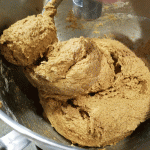 In the mixer bowl, combine the final dough ingredients and use the dough hook at low (KA2) speed to mix, scraping down as needed, until the dough develops into a dense mass that cleans the bowl and climbs the dough hook, 7-8 minutes.
In the mixer bowl, combine the final dough ingredients and use the dough hook at low (KA2) speed to mix, scraping down as needed, until the dough develops into a dense mass that cleans the bowl and climbs the dough hook, 7-8 minutes.
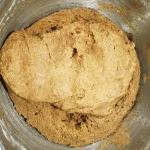 Cover and ferment at room temperature (70°F/21°C) until doubled in bulk, about 1 hour.
Cover and ferment at room temperature (70°F/21°C) until doubled in bulk, about 1 hour.
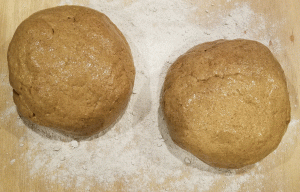 Turn the dough onto a lightly-floured work surface and divide into three pieces, each weighing about 875 grams. Shape each into a boule and place on a floured peel or proofing board. Cover the loaves and proof at room temperature until expanded to 1½ times their original volume, about 1 hour.
Turn the dough onto a lightly-floured work surface and divide into three pieces, each weighing about 875 grams. Shape each into a boule and place on a floured peel or proofing board. Cover the loaves and proof at room temperature until expanded to 1½ times their original volume, about 1 hour.
Preheat the oven to 395°F/200°C with the baking surface in the upper third. If desired, slash the loaves to a depth of at least ½”/1.5 cm and brush or spray with water. Bake until the loaves thump when tapped with a finger and the internal temperature is at least 203°F/95°C, 60-70 minutes. Transfer to a rack and cool thoroughly before slicing.
Baker’s Percentages:
| Ingredient | g | % |
| TOTAL FLOUR | 1,230 | 100.00% |
| Whole wheat flour | 600 | 48.78% |
| Whole rye flour | 430 | 34.96% |
| Red rye malt | 200 | 16.26% |
| Water | 600 | 48.78% |
| Buttermilk | 500 | 40.65% |
| Salt | 18 | 1.46% |
| Instant yeast | 11 | 0.89% |
| Syrup | 220 | 17.89% |
| Butter | 75 | 6.10% |
| TOTAL FORMULA | 2,654 | 215.77% |

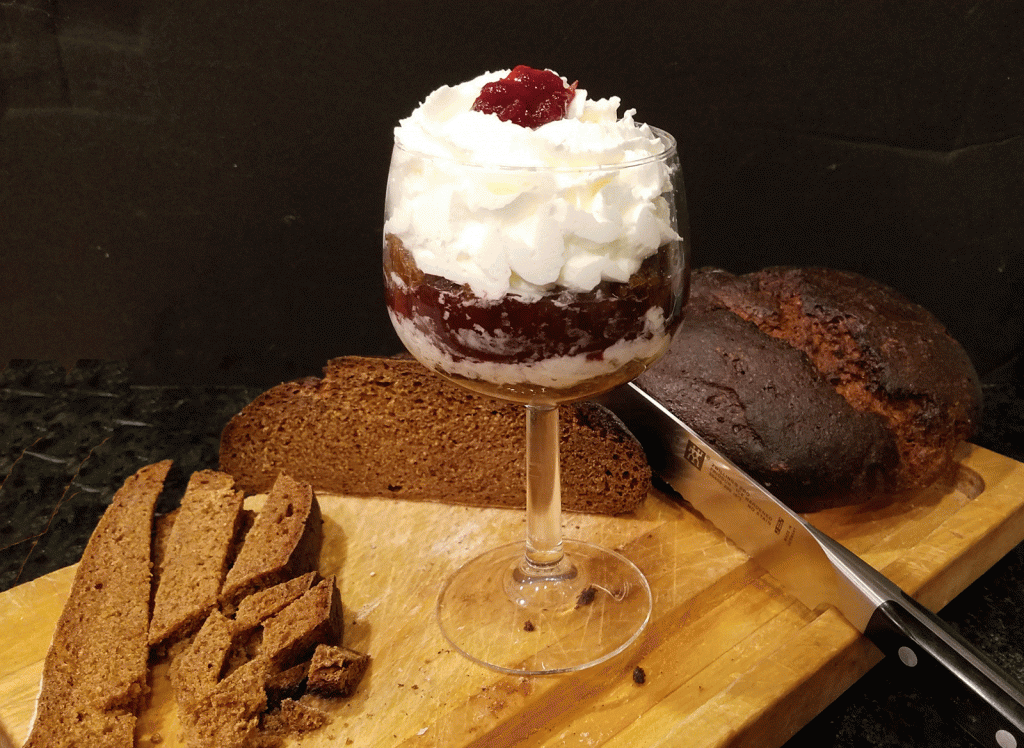
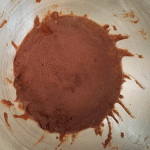
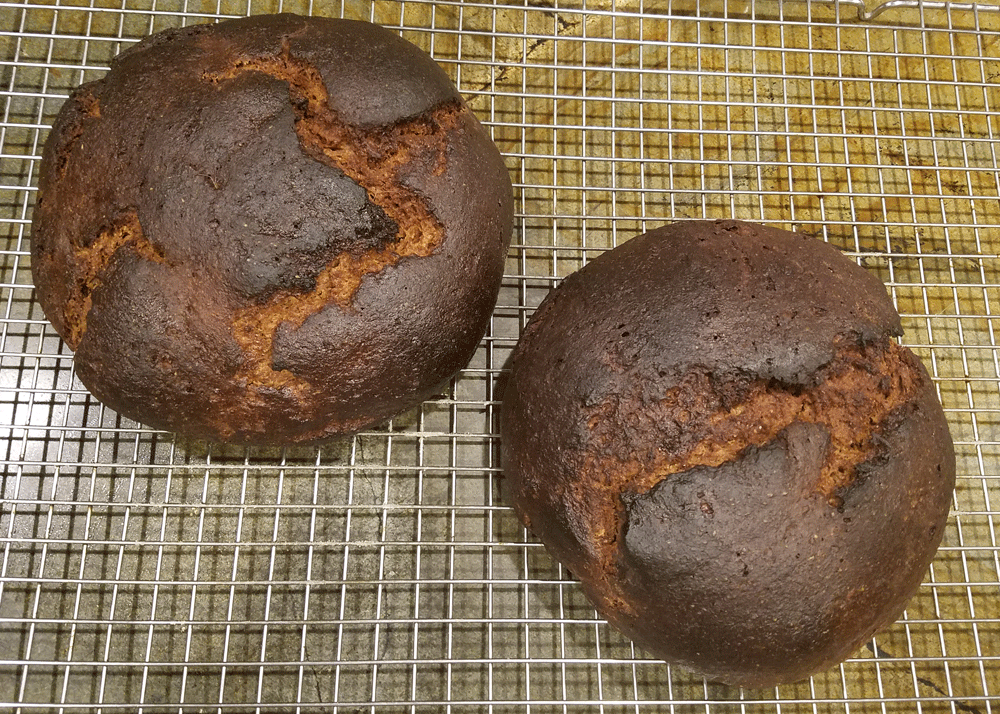
Collins Marisa
November 1, 2018And the dessert recipe?
🙂
Stanley Ginsberg
November 2, 2018Slice the bread thin and air-dry the slices, then make crumbs using a food processor, blender or rolling pin. You can either (a) soak the crumbs in a syrup-rum mixture, or (b) mix them with sugar and/or grated chocolate. Layer the crumbs with whipped cream and berry preserves. That’s it!
Stephanie Galinson
November 2, 2018What a lovely use of leftover bread. Thanks!
Jennifer Small
November 4, 2018Where can I get rye malt?
Stanley Ginsberg
November 13, 2018nybakers.com
Susan Paraska
November 12, 2018Hello. The red rye malt listed in bread making – where do I buy? I did not see it listed on the NYB site. Thank you.
Stanley Ginsberg
November 13, 2018It’s listed in the Rye Flour section … Fawcett’s Crystal rye malt.
Dan Erkkila
November 13, 2018Can you say more about the grind and sifting for the scald? Medium or coarse grind? What purpose does sifting serve? Mixing?
Stanley Ginsberg
November 13, 2018I generally sift to remove the larger pieces, which I then re-mill. The function of the sifting is mainly cosmetic.
Dan Erkkila
November 26, 2018Hi Stan, I made my first batch yesterday. It was typically sticky, but it wouldn’t hold a form very well. All measurements were by weight, but I did try adding a little more wheat flour to no avail. I put two loaves in standard loaf pans and the third, a boule, into a 9″ round cake pan. That one spread out to fill the pan, so it ended up being a flat loaf – no height. The rye flour was stone ground whole rye and the wheat flour was freshly ground red fife wheat berries @ a normal flour grind (not course). The flavor is amazing! Where did I go wrong or what should I try next time to get a form that would hold a boule shape?
Tiina
April 30, 2019Hi,
I was surprised to read about corn syrup. Corn does not grow in Finland, so I believe corn syrup is not in original recipes. In Nordic countries, usually it is rye malt syrup or molasses that is used in rye breads.
Stanley Ginsberg
April 30, 2019True, that. However, since rye malt syrup is generally not available here and molasses has a strong and distinctive flavor, I substituted corn syrup as a workable alternative. For myself, I generally use sugar beet syrup or dark sugar syrup from Holland in my breads (unless they call for molasses). If you can find rye malt syrup or something similar, by all means use it instead. Cane syrup and British golden syrup are also good substitutes.
Leah Behar
June 4, 2019Hii
Can this be done with diastasic malt flour? Thank you!
Cathleen
October 7, 2019When I made this the first time, I followed the instructions to the letter. I noted that the malt did not absorb all of the water in the scald. I made a pan loaf (my favorite form for malt bread in any case), and the bread was beautiful; it rose in the designated time and sliced well with a fine crumb. The next time I made it, I cut the amount of water in the scald in half. This version gave me a dough I was able to turn out on a floured surface and form a loaf. It also baked beautifully in the recommended times.
In both cases I made half the recipe. This works perfectly with a 4x9x4-inch Pullman loaf pan.
Norman
December 22, 2019Hi Stanley; I have been digging around some of the Finnish blogs looking at recipes and ingredients. One thing I noted is that when they use dark rye malt, kaljamallasta, it is sold as a coarse meal rather than a powder like in Germany or Russia. The kaljamallasta is used as part of the malts in the brewing of a traditional homebrew called sahti. It is ground as a meal to aid in extracting the wort from the mash. Most of the recipes for bread using this malt that I came across use it as a meal and some mention the additional grainy bite it imparts. This would explain the use for the scald just for that malt. Scalds are generally only used for three reasons: 1) For saccharification of starches utilyzing amylase enzymes which are denatured in red rye malt and not available for that purpose; 2) to gelatinize the starches in a portion of flour or meal as a means to bind the water to the starches, allowing for higher overall hydration of the dough and resulting in moister breads; and 3) as a shortcut to a long soak of meal to incorporate water into that part of the dough (while also binding the water to the starch). It seems it was used for the third reason
breadski
December 21, 2020Please tell me best make and source for Pullman pans. Thank you!
Stanley Ginsberg
January 17, 2021Buy steel. Most are made for professional bakeries, so quality is generally very good. Try webstaurantstore.com or Amazon.
Annette Seidenglanz
February 16, 2021Made mine with maple syrup…we live in VT so it’s very high quality amber!